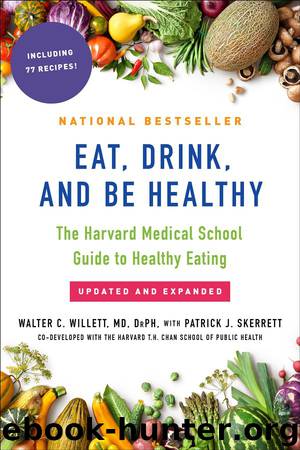Eat, Drink, and Be Healthy by Walter Willett M.D. & P.J. Skerrett

Author:Walter Willett, M.D. & P.J. Skerrett
Language: eng
Format: epub
Publisher: Free Press
Vitamin B6
This vitamin is actually six related compounds. They are mostly involved with breaking down protein from food into amino acids, the building blocks used to make new proteins. Taking in too little B6 causes a condition known as pellagra. Signs of pellagra include dermatitis (an inflammation of the skin), anemia, depression and confusion, and convulsions. Not getting enough B6 can also increase blood levels of homocysteine, an amino acid, which may increase the risk of heart disease (see “Homocysteine and the Heart” on page 213).
Many people take extra vitamin B6 to treat a variety of diseases and conditions, sometimes without much backing from scientific evidence. It is promoted as a remedy for premenstrual syndrome at doses far exceeding the recommended daily intake. A review of evidence suggests that 50 to 100 milligrams of vitamin B6 a day may improve the physical symptoms and depression that are part of premenstrual syndrome, but the evidence for this is weak and there is no justification for higher doses.6 Vitamin B6 has been used off and on to treat carpal tunnel syndrome. Although there’s little proof that this works, some people seem to get relief with doses of 100 to 200 milligrams.
One form of vitamin B6 helps convert the amino acid tryptophan into serotonin, an important chemical messenger used by the brain and nervous system. Because of this connection, B6 has been tested as a treatment for depression, attention deficit disorder, and other serotonin-related problems. Again, there’s no solid evidence to show whether it works or doesn’t work for these conditions.
Recommended intake: The recommended daily allowance for vitamin B6 is between 1.3 milligrams and 1.7 milligrams/day, depending on your age and sex.
Good food sources: The average American gets much of his or her daily ration of vitamin B6 from fortified breakfast cereals. Other good sources include meat, nuts, and beans.
Safety: Intakes of vitamin B6 that can be achieved only by high-dose supplements—250 milligrams/day—can cause nerve damage. The Institute of Medicine (now the National Academy of Medicine) set the tolerable upper limit for vitamin B6 at 100 milligrams/day from supplements.
VITAMIN B12
Early in the twentieth century, pernicious anemia was a grim and inevitably deadly disease. It sometimes started with paleness and fatigue, which were gradually accompanied by tingling and numbness of the arms and legs, memory loss, disorientation, and even hallucinations. In some cases, memory loss, disorientation, and hallucinations were the only symptoms. In 1934, three American researchers won the Nobel Prize in medicine for their discovery that injections of liver extract effectively treated pernicious anemia. These extracts worked because liver contains large amounts of vitamin B12, which is an essential ingredient for making red blood cells.
Today, full-blown pernicious anemia is uncommon. But getting too little vitamin B12 can still cause an array of problems, including memory loss and dementia, muscle weakness, loss of appetite, and tingling in the arms and legs. It can also lead to the accumulation of homocysteine, since vitamin B12 is involved in converting homocysteine into the amino acid methionine.
Because vitamin
Download
This site does not store any files on its server. We only index and link to content provided by other sites. Please contact the content providers to delete copyright contents if any and email us, we'll remove relevant links or contents immediately.
Nutrition for Sport, Exercise, and Health by Spano Marie & Kruskall Laura & Thomas D. Travis(3563)
Nutrition for Sport, Exercise, and Health by Marie Spano & Laura Kruskall & D. Travis Thomas(3555)
The Sprouting Book by Ann Wigmore(3422)
Flavor Flours by Alice Medrich(2652)
Memory Rescue by Daniel G. Amen(2269)
Superfood Smoothie Bowls: Delicious, Satisfying, Protein-Packed Blends that Boost Energy and Burn Fat by Chace Daniella(2241)
Dirty Genes by Ben Lynch(2168)
The Bad Food Bible by Aaron Carroll(2127)
The Poisoner's Handbook by Deborah Blum(1987)
Genius Foods by Max Lugavere(1979)
Good Calories, Bad Calories by Gary Taubes(1958)
The Main Street Vegan Academy Cookbook by Victoria Moran(1944)
The I Quit Sugar Cookbook by Sarah Wilson(1882)
Core Performance Essentials by Mark Verstegen(1866)
Memory Rescue: Supercharge Your Brain, Reverse Memory Loss, and Remember What Matters Most by Amen Dr. Daniel G(1856)
Big Girls Do It Stronger by Jasinda Wilder(1811)
Android App Development by Franceschi Hervé J.;(1738)
Sugar Crush by Dr. Richard Jacoby(1691)
Dr. Colbert's Keto Zone Diet by Don Colbert(1552)
